Everything that is described in the sightseeing is a musical theater, which means that it is impossible and inconceivable without music. The range of presented eras, names and styles is very wide: from Bach, Vivaldi and Bellini to the unchanging, irreplaceable Tchaikovsky, from Minkus and Puni to Asafiev, Melikov, Lyubovsky. A lot worked for those whom the audience does not see, whose fate is called the common name Orchestra. But we will recall those who answered them, who answered, as a plenipotentiary representative of composers, with gratitude for the quality of music: Maestro Evgeny Khilkevich (Yakutsk), Vadim Munster (Perm), Igor Latsanich (Kazan).
The crisis of our ballet is a purely metropolitan phenomenon

The game’s game abandoned me at the end of the theater season in three Russian cities – Yakutsk, Perm, Kazan, where I have repeatedly visited the old days, being a “young critic”. An important result of what he saw is the conviction that the unstable conversations about the crisis of our ballet is a purely metropolitan phenomenon. The so -called “province” does not speak about the crisis (there is simply no time for this), but works hard. Perhaps an omnipotent case intervened once again, but the panorama of the Russian ballet life (Siberia, the Urals, the Volga region) turned out to be surprisingly rich.
Yakutsk
On April 20–26, a festival of opera and ballet art was held in the Propolar capital. The cultural center of Yakutia, separated by thousands of kilometers from large cities of Russia, is needed such as air. In fact, this is the only way to see and show yourself. Performances and gala concerts with the participation of eminent artists from Moscow, St. Petersburg and other cities of Russia attract the audience (for Yakutsk with a population of a little more than one hundred thousand and six stationary theaters this is an urgent problem), and the young ballet troupe passes its universities here. The festival movement also supports the leadership of the republic, recognizing its significance. That is why in the difficult 1990s, ballet festivals (Northern Subtissage, Sterkh) were held four times, and the current one, which opened a new century, is already the fifth and also special: ballet-ooperal. The Union of two main genres of the musical theater obliged the solid – three -year – anniversary: 80 years turned to the Yakut Theater, 30 – the Music Theater and 10 – the State Opera and Ballet Theater, within the walls of which the festivities took place. The poster of the festival made it possible to judge the results of the multi -stage path.
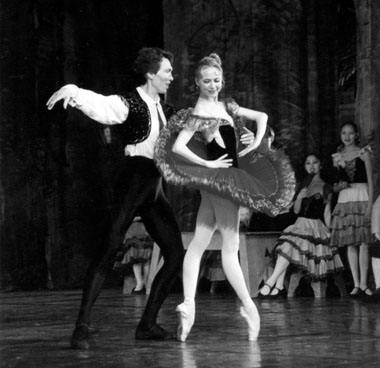
E. Knyazkova, I. Myasoedov in the play “Don Quixote”.
Photo from the author's archive
The operas “Prince Igor” and “Peak Lady”, the ballets “Swan Lake”, “Bakhchisarai Fountain”, “Don Quixote” – masterpieces of the musical scene, moreover, of Russian origin. Such a repertoire in itself is a quality mark.In addition, opera performances in the production of the chief director of the theater Sergei Chigirev were struck by surprise at the well -known one, and the ballet presented a lot of surprises.
The festival was opened by Swan Lake in the editorial office of Yuri Grigorovich, who met with the Yakut troupe last season. The work of a world -famous choreographer, the development of a large -scale performance designed for a first -class troupe – Maria Sayydykulova took a chance to solve this task, coming to the leadership of a ballet team. And although Grigorovich’s staging, having lost its former sensationality, is perceived now as a respectable classic, in the history of the Yakut ballet this is a stage line. The accumulated experience and intensive replenishment of the troupe with graduates of his own choreographic school, which appeared next to the theater several years ago, helped to rise to such a height.
By tradition, the owners of the festival and guests met on stage. Ballerina from Moscow Oksana Kuzmenko (Odette-Odilia) danced with Sayan Ulturgashev (Prince Siegfried). The skill of the metropolitan Prima and the completely understandable timidity of her young partner was added by unforeseen, but in their own way the intriguing overtones to the history of lovers. The artists of a noticeably younger corps de ballet and new soloists did not play: there were even lines and specifically Yakut expressiveness, that is, soft grace and musicality of the dance.
The Bakhchisarai Fountain in the editorial office of Kirill Schromerger (the main choreographer of the Perm Theater) is the premiere of this season. The work of the director was reduced to replacing some dances with his own. Why it was necessary to improve the first-born of the Soviet classics, and not to make the whole ballet in his own way, remained a mystery. This time, Tatyana Serova, a novice soloist of the Mariinsky Theater, was an honorary tour of honor. Her tall, majestic Zarema really looked like a guest among the natural oriental beauties, over which she rose regally. Even the harsh weight – the prime minister of the troupe Igor Myasoedov sometimes clung at the sight of this noble miller.
Completed the anniversary review Don Quixote – the favorite of the Yakutian. I do not spread about him with my hands, since the author of these lines in 1993 carried out the production of the famous Ballet of the Ministry of Crimea – Gorsky. I note with joy that the performance did not get sick, not faded. With enthusiasm, as in the premiere, the previous and new performers of Gulnara Dulov – Mercedes, Oksana Abramova – lord Driad, Ekaterina Tyshina and Dmitry Dmitriev – Tatyana Alekseeva – Amur, Aitalina Nosova and Daria Dmitrieva – flower beds are dancing; Fresh colors were found in comedy characters Sergey Afonasevich – Gamash, Grigory Savinov – Sancho Pansa, Yuri Zubkov – Lorenzo. For some time, Tatyana Serova, a street dancer and S. Ulturgashev-Espada, took possession of the scene, and Elena Knyazkova led the performance. The title of the queen of the festival, if such, would be provided to her.
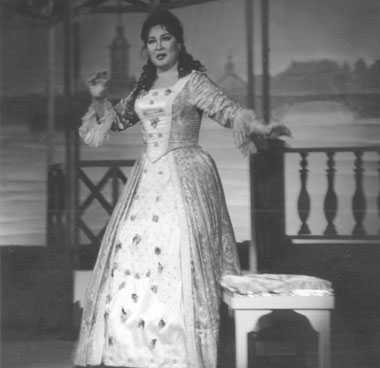
AT.Tsydypova (Lisa) The Queen of Spades.
Photo from the author's archive
A Muscovite at the place of residence, Knyazkova (gold winner of international competitions) preferred contract work to service in the theater. Her stage platform is the stages of the whole world. The status of a “free artist”, unthinkable in the old days, is just right for her: this does not affect the quality. Charming appearance, fabulous legs, feminine charm and perfect technique – here she is, a ballerina by the grace of God. A dance of jewelry without any noticeable effort. And the duet with Igor Myasoedov – Basil turned out to be amazingly good. And it's not just about the experience and dexterity of the partner. The common tonality of their dance turned out to be quite unusual in Don Quixote. Both danced with a twinkle, but without pressure and pathos, in a manner that can be called intelligent. The playful nature of the ballet did not suffer at all from this, but the culture of the spectacle gained noticeably.
Ballet and opera met again at a gala concert. Vocal classics sounded in the first part, the second one, given to ballet, reflected the face of today's troupe. And the final chord was the march from Aida – an ocean of jubilant sounds cut through by the powerful voice of Nina Chigireva. The jubilation also seized the audience, who felt themselves witnessing an extraordinary event, and in the annals of the Yakut theater – an event, without exaggeration, historical.
Who knows if the handsome heroes from Nizhny Novgorod Vladimir Ermakov (Igor) and the unique Yakut bass Ivan Stepanov will ever meet again in Prince Igor? Is it realistic to repeat the Queen of Spades, where no matter what the name is, then a celebrity – Russian or world? Vladimir Shcherbakov – Herman (Bolshoi Theatre) – restless, recklessly young despite the advanced age of the artist. Vladimir Ermakov – Count Tomsky and Zlatogor – both thoroughbred, well-groomed. Valentina Tsydypova – Liza (Mariinsky Theatre), about which it is permissible to say: “Beauty. Goddess. Angel. Aitalina Adamova as Polina and Milovzor is a rising Yakut star accepted into the Mariinsky Theatre. Finally, Anegina Ilyina is a living legend of the opera stage, who presented the countess as an imperious, dignified old woman and the fatal Queen of Spades in one person.
Three mezzo-sopranos of rare beauty and strength, three talented singers of different generations will remain in the memory of eyewitnesses as the emblem of the anniversary festival. The specificity of the ballet excludes the possibility of demonstrating the continuity of generations. But in the hall and backstage was Evdokia Stepanova – the first Yakut ballerina with a diploma from the Vaganov school, the queen of ballet in 1950-70, a historical figure. And on the stage, next to the masters, young people danced: Maria Degtyareva, Evgenia Starostina, Daria Dmitrieva, Sayan Ulturgashev, Petr Sidorov, Grigory Savinov – the present and future of the Yakut theater. They have someone to look up to, with whom to take an example.
Dmitry Dmitriev performed brilliantly at the festival, once again proving that it is not external data (height, shape of legs, etc.), but talent that determines the fate of a dancer.And although colleagues portray high-born heroes of ballet classics, Dmitriev is much more interested in heroes of the “second plan”. It is in them, not constrained by manners and other conventions, that life boils, passions seethe, and each one has its own national and human way. Nurali in The Fountain of Bakhchisarai, the Jester in The Swan, the Polovtsian in Prince Igor, the Gypsy in Don Quixote – everywhere has its own habit, character, plasticity. But one thing is invariable – the storm and onslaught of the virtuoso, boldly attacking any technical height, the joyful feeling of the stage owner, who gives everything he owns to the performance and the audience.
All the impressions of the festival week would be enough for another theatrical season. A lot of people – specialists of various profiles – participated in the preparation and holding of such a major event. All of them deserve gratitude and admiration, the names of many will remain in the annals of the Yakut musical theater. And since good deeds are not complete without the intervention of good spirits, let's name a person who has a direct connection with them. The author of the idea and the artistic director of the festival, Lira Gabysheva, was called the “muse” for a reason. This graceful, charming woman, indeed like a fairy, has many talents and is completely devoid of vain ambitions. Whatever she does – she collects the collection of a theater museum, composes a ballet, or invents and organizes a festival celebration – she is driven by a pure flame of love for beauty. Is that why she manages to carry out the most daring plans? Isn't that why this grandiose, laborious, truly historic festival was a success?
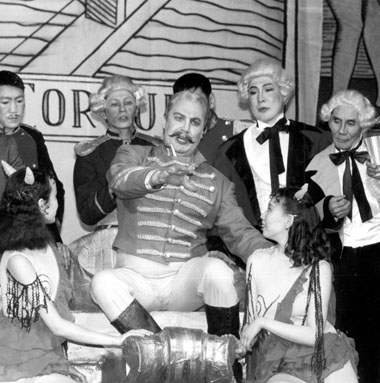
V. Ermakov (Tomsky). The Queen of Spades.
Photo from the author's archive
PERMIAN
The event, for which specialists from Russia and the USA gathered here in May, deserved it: the premiere of An Evening of Choreography by George Balanchine and the scientific symposium Balanchine – Petipa timed to coincide with it. Many organizations from the American side (from the Balanchine Foundation to the Philip Morris Company) participated in the implementation and financing of the international project, from the Russian side – the local administration and the theater itself. The producer was David Eden, who did a lot for our ballet. Thanks to him, in 1995, a large-scale cultural event dedicated to Bronislava Nijinska was held in St. Petersburg (the production of the famous Les Noces in Malegota and a representative international symposium). Recently Eden organized the first tour of the ballet of the Moscow Bolshoi Theater throughout America in post-perestroika times. David is also remembered in Perm, where, on his initiative, in 1996 Balanchine's Concerto-Baroque ballet (staged by Adam Lueders, USA) appeared. Perhaps then the idea of a new project was born on the Permian land, with its famous ballet, in the city, vitally connected with the name of Diaghilev.It is difficult to say how and when the plan would have been realized if Oleg Levenkov had not been in Perm. It was he, a passionate admirer and indefatigable researcher of Balanchine's work, who determined the program of the ballet evening and the symposium, finding, together with David Eden, ways to implement the plan.
From Balanchine's extensive heritage, three one-act ballets were selected that had not yet been “noticed” by St. Petersburg and Moscow: Donizetti Variations, Concerto Baroque (already familiar to Perm audiences) and Sleepwalker. These compositions turned out to be an eloquent illustration of the topic of the scientific symposium with the participation of prominent Russian and American ballet experts. Different in genres and artistic tasks, the Master's works presented him as a continuer of the classical traditions bequeathed to the 20th century by Petipa, and as a discoverer of artistic worlds still unknown to the ballet scene.
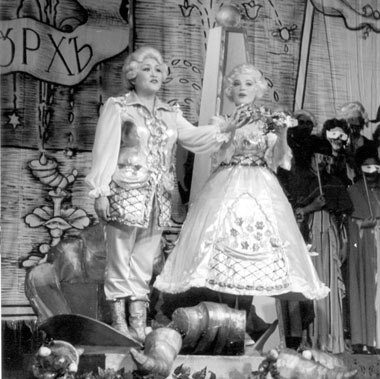
A. Adamova (Milovzor), A. Zgonnikova (Prilep). The Queen of Spades.
Photo from the author's archive
The plot Sleepwalker to the music of Rieti (based on Bellini) resembles the type of dramaturgy and philosophical concept of the ballets of romanticism. In the Donizetti Variations, the sparkling flow of the dance is organized from within by the grand pas structure honed by Petipa (entre, adagio, variations, coda). But “Concerto-Baroque” to the music of a concerto for two violins and string orchestra by J.-S. Bach is already “pure” Balanchine, modeling the form as a dialogue between choreography and music without any intermediaries. Here Balanchine trusts only his own inner hearing, his own intuition.
All three ballets were enthusiastically received by the audience, although it is not at all easy to surprise Perm balletomaniacs who have been brought up on the best examples of classical and modern choreography. The hero of the premiere can without a doubt be called a talented, highly professional Perm troupe that danced Balanchine as if they had been doing just that all their lives. It was 38 days of extremely difficult and equally exciting work. Bart Cook and Maria Calegari, former soloists of the New York City Balle troupe, who worked under the guidance of the Master himself, helped to master the technique and style of Balanchine. Both were satisfied with the process and the results. “There were no technical difficulties,” Bart concluded, “but the real work began when the artists learned the movements and understood their meaning: then their bodies sounded like musical instruments, and a beautiful song arose. It was happiness.
It was also a blessing for art connoisseurs to see the ingenious choreography in a masterful performance. It is not often that such a perfect performing ensemble appears even on the stages of the capital, when the corps de ballet and luminaries joyfully do a common job. And what ballerinas in Perm!
The extra-class dancer Yulia Mashkina literally struck sparks with pointe shoes in Donizetti, and in Concerto Baroque, becoming the voice of the first violin, she sang Bach’s melodies with her body so that Pushkin’s “bow is obedient to magic” was recalled.The second violin part was conducted with dignity by Natalia Makina.
The subtlest ballet actress Elena Kulagina-Somnambula has transformed into a mysterious creature, forcing you to feel the breath of the otherworldly. The unusual complexity of this role lies in its languagelessness: there is no plasticity (there is a lit candle in the hands of the Somnambula), movements are limited to the pas de bourre. But her chosen one, the Poet, is also deprived of dancing speech. This requires mutual sensitivity of partners and expressiveness of a special kind, comparable to the inner music that only the characters hear. The poet – Vitaly Poleshchuk, a dancer of noble appearance and exemplary stage culture – showed such sensitivity.
Divertimento Somnambulists was decorated with easy-artistic dances by Yuri Higuchi and Alexei Lysenko (Oriental dance) and Nikolai Vyuzhanin (Harlequin). Confidently followed its course in the stream of Donizetti Variations jumping young trio – the same Vyuzhanin, Konstantin Olyunin and Oleg Posokhov. Alexander Volkov appeared as a master of duet dance in Concerto-Baroque. And, perhaps, the main discovery of the Balanchine evening is the young Sergei Mershin, who made his debut in Variations as a true prime minister.
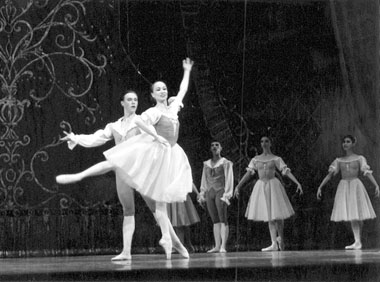
Y. Mashkina, S. Mershin Concerto Baroque.
Photo by Y. Chernov
After such a brilliant performance, the troupe who worked hard for glory would have been the time to relax. But Balanchine was followed by Swan Lake (with E. Kulagina and V. Poleshchuk in the lead roles) and Petipa's Evening – Shadows (with Y. Mashkina and D. Lobas) and Cavalry Halt (with N. Moiseeva – more one brilliant Permian ballerina and debutant S. Mershin). It is pleasant to note that all these performances are connected with St. Petersburg: The Swan is staged by Nikolai Boyarchikov, The Halt of the Cavalry is staged by Pyotr Gusev, and Shadows has recently been transferred to the Perm stage by Natalia Spitsyna, choreographer-repetiteur of the Mariinsky Theatre. It is tempting to see the Petersburg-Leningrad genes of the Perm Ballet not only in the artistic policy of the leadership. Everything, from the idea of the Balanchine celebrations to their excellent organization and direction (including the beautifully published program booklet with information about all the main participants in the event), speaks of the responsibility of the people of culture involved in it.
Kazan
The ballet of Tataria also has Leningrad roots. St. Petersburg choreographers helped him get back on his feet, the Vaganov School trained national personnel, and the first Tatar ballet Shurale (Ali-batyr) was given life by St. Petersburg resident Leonid Yakobson. Not without colleagues from the banks of the Neva, and now, many years later, when the time has come to see the light of a new brainchild named Yusuf.
The background in a nutshell is this. According to one of the authors of the ballet, Nikolai Boyarchikov, he once conceived a play based on Thomas Mann's tetralogy Joseph and His Brothers with music by Alfred Schnittke, but the idea was not realized.Later, the music for the ballet was proposed by Leonid Lyubovsky, a well-known composer living in Kazan. The basis for the new libretto, owned by the Tatar poet Renat Kharis, was the poem of his distant predecessor Kul Gali, a monument of the Bulgaro-Tatar literature of the 8th century. In the process of cooperation between the composer and the choreographer, the contours of the ballet gradually cleared up and took on their final form, when Georgy Kovtun, a student and colleague of Boyarchikov, joined the work. After a long search, the graphic designers were also determined – Andrey Zlobin from Kiev (scenography) and Anna Ipatyeva (costumes).
The ballet-parable “The Tale of Yusuf” (as the biblical Joseph the Beautiful is called in the Koran and Muslim literature) matured for a long time, but acquired stage forms surprisingly quickly. It took only a month for G. Kovtun to compose a three-act performance, and for the artists to master the unusual, sometimes seemingly impossible choreography, which at first was almost met with hostility. Perhaps they would not have had enough for that year if Evgenia Kostyleva, who was urgently involved in rehearsal work, had not appeared in the theater – in the past a prima ballerina in Kovtun's Kyiv troupes, and in recent years – a tutor of all his ballets and, as it turned out, a first-class tutor.
An enviable capacity was shown by the artistic and production part, masters of costumes, shoes, props, etc. Their skillful hands turned the fantasies of the artists-authors into reality and, pardon the pun, the reality is absolutely fantastic.
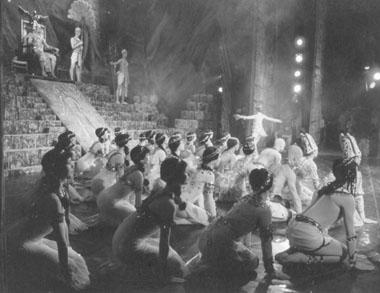
A scene from the play The Tale of Yusuf.
Photo from the author's archive
Legendary antiquity, now austerely severe, now riotously exotic, dazzling with luxury of colors and forms, is revealed with the help of a system of moving panels and a high platform in the center of the stage, with camouflaged stairs on the sides. The solution of space allows you to instantly change the scene of action – from palace chambers and dungeons to landscapes and space – and design mise-en-scenes at different levels, multiplying spectacular effects.
On an ocher, ultramarine or scarlet background, costumes sparkle with all the colors of the rainbow. There is so much beauty and invention in them that during the performance you do not have time to enjoy them and look with regret at the closing curtain.
The splendor of the spectacle helps to enter the world of L. Lyubovsky's music – expressive, multicolored, but somewhat heavy for perception due to overloaded sonority and tangible length. The author of many large-scale compositions, and in addition, a talented music writer, in his first ballet score, preferred freedom of expression to “freedom in fetters” (in the words of Glazunov) – that is, voluntary submission to the specifics of the ballet genre. Therefore, the merits of the music – the theatrical-bright contrast between the brutal worldviews and the unsteady meditations of Yusuf, the whimsical rhythm of the divertissement numbers and the delicate sound writing of the chamber scenes – still do not atone for the melodic insufficiency, the absence of leittems that are easily grasped by the ear, like the one that occurs in the final episodes of the ballet.
The ingenuous puppy-heavy melody is repeated many times, changing the instrumental cleaning, and on the stage the last monologue of the hero unfolds, which the woman who loved and betrayed him echoes. By this moment, the plump action had already ended, remained behind Yusuf’s ordeal – a bright spirit and the face of the lad, sinless, like the Lamb of God. He knew the laws of the cruel world: the evil envy of the brothers, who gave it into slavery; The short patronage of the pharaoh and the severity of his punishing hand; The revenge of the crowned beauty, wounded by his innocence. Yusuf – the prototype of Jesus Christ – forgives everyone and leaves the sinful world, slowly offending the ground, washed by star rain. And under him, in the thickening darkness, a lonely woman in the golden vestigo of the earth's goddess cries about unfulfilled happiness. A quiet complaint sounds like a prayer for all people, about the fate of the world. At this moment, the performance soars to that emotional and philosophical height, for which it must have been conceived. It's time to return to its directors.
Choreographers of different generations, various creative inclinations formed a harmonious whole. Boyarschikov determined the general decision and structure of the performance, resorting to a favorite directorial technique: “real” characters are accompanied by symbol characters who personify the highest, respondal forces. The ballet begins with a duet of the sacred scarab beetles, to which the cordbath of stars joins. They do not affect the course of action, but demonstrate the God -chosenness of Yusuf, supporting his spirit in difficult times. Yakub is also ambiguous – the hero’s father: his plot function is completed in the first act, in the future this is a kind of commentator on events, their moral tuning fork.
A noble old man in white clothes, Yakub – the only one around the world disinterestedly loves Yusuf, is experiencing his suffering as his own. The rest – in pursuit of profit and carnal pleasures – are hostile and indifferent. Only in misfortune do people recall Yusuf languishing in imprisonment, but too late: the hero leaves them. So that the chosen one of God will return to Earth, the world must become different. But will it become?
The performance ends with a question to which there is no answer. But to the question of whether the ballet was able to answer it is not difficult: quite. First of all, because serious problems and complex music did not deprive him of a generous dance. The choreographic text was composed by the city of Koktun. Incredibly efficient, dynamic and versatile gifted (on it is more than three hundred ballets and a countless number of productions in adjacent genres), Kovtun comes up with movements, as he says. His fantasy knows no boundaries. The dance pours out of it with almost not controlled freedom and often erodes the form, overturning the barriers of taste. This time, the process was controlled by his teacher, ruthlessly compartment “surplus”, and a dance stream, without having lost spontaneity, flowed into the calculated channel.Kovtun owns and properly manages all existing dance systems, parterre and aerial acrobatics (this is his strong point). And if in the compositions of the classical corps de ballet (Zvezda) the influence of Boyarchikov, a specialist in “metaphysics”, is noticeable, then Yusuf’s monologues, the frenzied dance of the Brothers, the extravagant Egyptian divertissement (equal in duration and variety of numbers to the concerto) and, especially, the finely crafted ten-minute duet of Yusuf and Zuleikha (Pharaoh's wives) bear the stamp of Kovtun's free talent and his mature skill.
A precious find is the last monologue of Zuleikha, piercingly tender and bitter. I have never seen anything like it on the ballet stage. The dancer in the ceremonial attire of the queen looks like a golden figurine. She does not move, her hips and knees are closed, her face impassive. Only hands “speak” – hands, elbows, fingers. Each pose is an instant freeze-frame, a hieroglyph sign. But this poetic message does not require decoding, its meaning is clear without words.
“The Tale of Yusuf” is the result of collaboration between major artists from three republics (Tataria, Russia, Ukraine) or (politically more accurately) two countries. This alone makes the performance an event. And although the troupe realized this fact with some delay, before the premiere – on hot summer days at the very end of the season – the actors worked like hell, knowing that everyone is irreplaceable. How it was possible to create the illusion of an academic troupe staffed in all respects, like the Bolshoi or the Mariinsky Theater, knows the artistic director of the ballet Vladimir Yakovlev. Let's reveal the secret. By chance, I became aware that the prime minister of the troupe, People's Artist Bakhytzhan Smagulov, between stage appearances in the extremely complex part of the Scarab, managed to throw on a shepherd's mantle and disappear into the crowd, so much so that no one noticed. This is just one example of acting decency and professionalism, but it says a lot.
The impression from the Kazan troupe, perhaps, is no less strong than from the performance as such: a disciplined corps de ballet, which in a short time mastered new, very difficult music and choreography; a strong group of male soloists (now a rarity), interesting and different ballerinas. Culture and thoroughness in the work of the performers of the main roles (it’s somehow embarrassing even to call the co-creators of the choreographer “performers”).
Yakub Rifat Abulkhanov is simple and noble as the truth itself. Each gesture in a laconic plastic role is significant, weighty, and it is impossible to play nobility – you need to have it.
The Pharaoh of Denis Mochalov, chained in gold, is an impenetrable idol that has suppressed a person in himself.
The wife of Pharaoh Zuleikha with Elena Kostrova is a spoiled and weak woman. Yusuf for her is an expensive toy that she broke without hesitation. For Elena Shcheglova, this is a tragic figure: she sacrifices an unlawful feeling to lust for power.
The theater entrusted the title role to Artyom Belov, yesterday's graduate of the Kazan choreographic school, who has an excellent technical base. Excellent rotations and flights with youthful flexibility of the body and not at all a youthful will decided the success of the debutant. He did not have to portray the adult purity of the soul: as long as the most natural.
It was not necessary to transform another, more experienced actor – Nurlan Kanov, who was dancing at the premiere. It was as if nature itself made sure that the theater was such a yusuf – a handsome man with an amygdala of black eyes, folded like a god. But the sophisticated beauty of the plastics, the inner light radiated by the hero is the merit of the artist.
A performance of a similar scale and an artistic level – out of the ordinary event, not only for Kazan. You can congratulate the whole ballet Russia.
Finishing the essay on the spring-summer impressions, it is tempting to associate what they saw with the flowering of nature (after all, even in North Yakutia the sun almost did not come in), and at the same time rejoice at how the cities themselves were flinent (one ballet school in Yakutsk-this “poem In marble ” – deserves a special story). But there are matters and more important.
Everything that is described in the sightseeing is a musical theater, which means that it is impossible and inconceivable without music. The range of presented eras, names and styles is very wide: from Bach, Vivaldi and Bellini to the unchanging, irreplaceable Tchaikovsky, from Minkus and Puni to Asafiev, Melikov, Lyubovsky. A lot worked for those whom the audience does not see, whose fate is called the common name Orchestra. But we will recall those who answered them, who answered, as a plenipotentiary representative of composers, with gratitude for the quality of music: Maestro Evgeny Khilkevich (Yakutsk), Vadim Munster (Perm), Igor Latsanich (Kazan).
It was perfectly said once: “De la musique Avant Toute Chose”, which means “music first of all”. So it was, is and will be.

